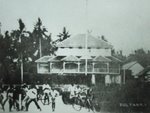
I have never enjoyed ambuyat but the rest of my family does. The bit I enjoyed about it are the side dishes that go with it but ambuyat is something that I am never used to. Some say you are not a Bruneian if you don't eat ambuyat. But then I do eat lots of other Brunei things which other Bruneians won't even look at like belutak, so there. Anyway, I was reading a Malaysian newspaper, the Star where it featured Brunei's 'national' dish, the ambuyat and I thought I will reproduce it here.
Eating Glue
Brunei’s national dish, ambuyat, has the colour and consistency of wallpapaper glue. Fortunately, a range of delicious accompaniments make it more than just edible.
By GRAHAM SIMMONS
It’s official! The Sultanate of Brunei really does have its own national cuisine. If, that is, you can really call ambuyat a “cuisine”.
Ambuyat, a dish prepared from the sago palm, has the texture and consistency of wallpaper glue. It became the staple dish of Bruneians during the Japanese Occupation in World War II, when people were reduced to near-starvation. Frequently, the only thing left to eat was the pith of the sago palm.
But the use of the sago (Rhumbia) palm as a foodstuff goes back a long way. Indeed, the Indonesian name of Borneo, Kalimantan, is derived from the word Lamanta, meaning “sago starch”. Accordingly, I felt that I was following in hallowed footsteps when I joined my friends for an ambuyat feast at Brunei’s Aminah Arif Restaurant, in the Kiulap precinct of Bandar Seri Begawan.
The preparation of ambuyat is an involved process. The first step is to extract the pith from the trunks of the sago palm. This pith is then grated and dried, forming a fine sawdust-like flour. This is later emulsified into a starchy paste called ambulong.
Ambulong is available widely throughout Brunei, including from stalls at the Gadong night market. When ready to be cooked, it is placed in a saucepan and boiled with water until it becomes a thick, gooey, rubbery paste that would be perfect for gluing the soles back on your shoes.
In the Aminah Arif Restaurant, a big bowl of ambuyat graces the centre of the table. I’m yet to learn how to eat this concoction, but my kind host explains the process.
“You use these special chopsticks to twirl the ambuyat like spaghetti around it,” she says, pointing to an unusual implement looking like a forked stick, and made from the branches of the sago palm. These joined chopsticks, called chandas, are to the best of my knowledge unique to Brunei.
Were it not for the range of side-dishes accompanying the ambuyat, I fear that I would be gagging all through a meal of this bland offering. But it was quickly explained that the first step is to dip the ambuyat-coated chandas into a special ambuyat sauce, made from salted durian, lemon juice, belachan (shrimp paste) and binjai, a mango-like Bruneian fruit. Infused with this sauce, the ambuyat tastes quite delicious.
Other side-dishes traditionally accompany a meal of ambuyat. One is a preparation of pakis or ferns sautéed with ginger and garlic. Another consists of boiled fish in a super-hot sauce made from bird’s eye chillies. There is also a range of salads and other accompaniments. These totally transform what might otherwise be hardship fare into a real banquet.
And for drinks, what better than teh tarik, a frothy tea prepared from powdered local tea-leaves. This beverage has a unique flavour, far removed from standard teas. By now, I’m starting to think that Bruneian cuisine is one of the world’s last undiscovered secrets.
A range of Brunei cakes – kuih talam (sticky rice with pandanus leaf jelly), kuih tako (pandan-coconut cakes) and others complete the meal.
These subtly-flavoured delights are the products of a well-established Bruneian cottage industry, with many households in the Kampong Ayer water village producing cakes and other sweets from their elaborate kitchens.
Had there been enough room in my stomach, I would also have tried another Bruneian specialty, rojak sotong, originating from Kuala Belait – somewhat like the Indonesian salad gado-gado, but with some unexpected flavours. Principal ingredients are sweet turnip, cucumber, pineapple and calamari, all served with a spicy, piquant sauce. An unforgettable taste-symphony!
Eventually, it was time to leave the Aminah Arif Restaurant. By then, I had finally discovered the secret of ambuyat – it is not so much a food in its own right as an excuse to enjoy all those yummy side-dishes!
The author visited Brunei as a guest of Royal Brunei Airlines and the Empire Hotel & Country Club.












No comments:
Post a Comment